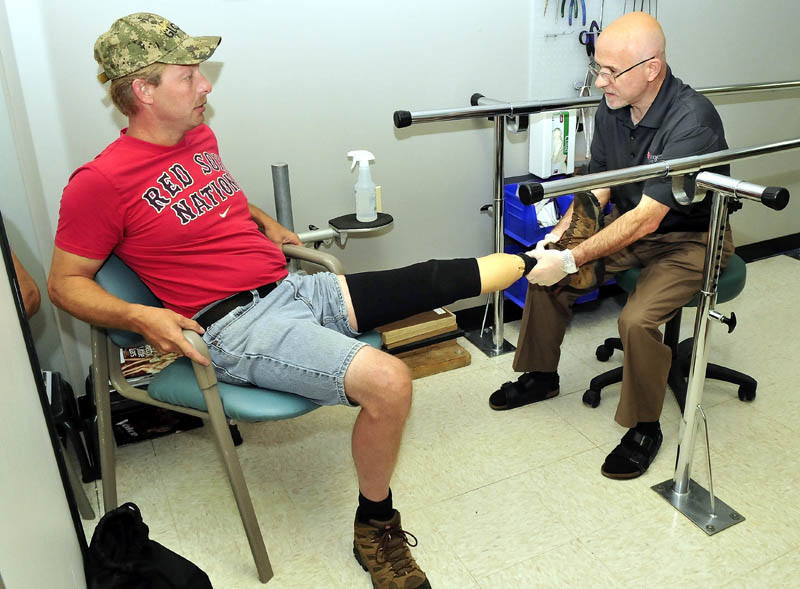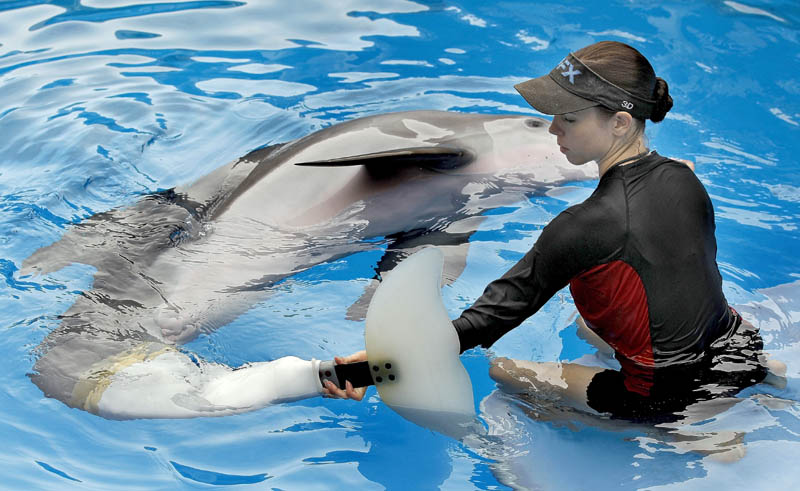WATERVILLE — Roland McLaggan was helping out a friend with a construction project when he fell off a roof and badly twisted his ankle.
He spent three years going to doctor’s appointments in Bangor, Portland and Boston before doctors decided he should have his lower left leg amputated because of avascular necrosis, which is when the blood supply to bone tissue is cut off, killing the bone tissue.
“It’s a tough situation but they told me that in the long run I would probably be better off with an amputation,” said McLaggan, 41, who lives in South China.
It has been about two years since McLaggan’s lower left leg was amputated and he was fit for his first prosthetic device. On Thursday he was one of about 30 amputees, some coming from as far away as Aroostook County, to consult with Kevin Carroll, a prosthetist and the vice president of Hanger Prosthetics & Orthotics.
Carroll, who is visiting Waterville from Orlando, Fla., is known for developing the first prosthetic device for a dolphin at the Clearwater Marine Aquarium in Clearwater, Fla., as well as his work in educating and working with clinicians and prosthetic users around the world.
He was portrayed by Morgan Freeman in the 2011 film “Dolphin Tale,” about his work creating a prosthetic tail fluke for Winter, a dolphin who was trapped in a crab trap. Carroll said that when he heard Winter’s story, his heart went out to her and he thought he could help make her a new tail.
Along with prosthetist Dan Strzempka, Carroll developed a prosthetic tail for Winter that attached to her body using suction and could propel her through air and water. He said that he continues to research prosthetics for animals as well as humans.
“There is a lot to learn from clinicians and patients and I like to encourage them to be adventurous and open minded,” said Carroll during his visit to the Hanger clinic in Waterville.
McLaggan said that there are challenges and inconveniences that come from living with a prosthetic device. For instance, he has to take it off to take a shower and when he goes to bed.
He has also gone through a significant adjustment adapting to life with the prosthetic. Scott Hebert, a prosthetist at Hanger who works with McLaggan regularly, said he is making progress.
On Thursday, Carroll, who was meeting McLaggan for the first time, watched him walk a short distance around the room.
“On the street you would never know he has a prosthetic device. He is right on track for where he should be following his surgery two years ago,” said Carroll.
Still, there are some things McLaggan struggles with, including balance and muscle weakness, which is largely because of a lack of use during the three years doctors spent trying to save his lower leg.
McLaggan was fitted with a prosthetic immediately after his amputation and since then has had three different prosthetics. Carroll said it is normal for amputees to have to be refitted for a new prosthetic after an amputation and the swelling of their limb goes down. During the three-year period which McLaggan calls his “downtime,” the muscles in his left leg began to atrophy and he is just now starting to regain that strength, he said.
The prosthesis, which includes an ankle socket and prosthetic foot, attaches to his upper leg below the knee with an airtight sleeve that holds it in place. There are some days when the prosthetic, which weighs about four pounds, can feel so heavy he is limited to two or three hours of activity at a time, McLaggan said.
Carroll said that in the future he sees prosthetic devices that directly attach to a person’s body. Right now there are only three or four amputees in the United States that have that technology, he said. He also envisions what he calls microprocessors, computer technology that would pick up on surroundings and help amputees with movement.
For now, he said a large part of what he does when he visits with patients is try and make them more comfortable.
The experience of each amputee Carroll meets with varies depending on how long they have been using their prosthetic and their previous medical history, but many complain of skin irritation, he said.
In his development of the prosthetic device for Winter, the dolphin, Carroll also developed WinterGel, a gel that is used to treat skin irritation on human patients.
McLaggan’s struggle with balance is also something recent amputees often experience and can be improved with strengthening surrounding muscles, said Carroll.
“There is something to learn from every encounter with a patient. Their comments and ideas are something we listen to and bring back to some of the best researchers in the world,” said Carroll.
McLaggan said he doesn’t see himself returning to his work as a mechanic and carpenter, but he is hopeful that as time goes on he will be able to do most things.
“I think that as an amputee you can probably do most things, you just have to find different ways to do them,” said Hebert.
Carroll, who is originally from Roscrea, Ireland, said he became interested in prosthetics while volunteering at a hospital there. Today, as he visits with patients, he said he hopes to offer them support.
“Its not just a loss of a leg, its an emotional experience,” he said.
Rachel Ohm — 612-2368
rohm@mainetoday.com
Send questions/comments to the editors.





Comments are no longer available on this story